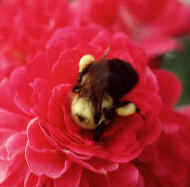![]()
Pollinator Paradise Pollination
Ecology at UI The
Solitary Bee Web
Rearing Solitary Bees
Suppliers References
Bee Gardens FAQ
Links Contact
Us
New Mexico Native Bee Pollinator Project About
Dr. Strickler
Bee Nests and Accessories Bee Photo
Gallery
Trapnesting Wasps and
Bees
![]()
 |
Q: Since Spring we began to notice an increasing amount of bumblebee activity in and on the outside of a yet-to-bloom front hedge of some type. Now, I find it virtually impossible to trim this pollinated and blossoming hedge due to the large bumblebees that seem to continuously swarm nearby. I have heard the loud "buzzing" that comes somewhere within this hedge and have decided to leave it alone, although, it needs trimming desperately. Many of these bees are quite large, with others of a smaller to medium size. |
A: This question was posed to a group of bumble bee experts on the internet, and here are some of their responses (slightly edited). Be sure to read them all, especially the last (#4).
1. How wonderful that you have a healthy population of bumblebees! It is a commentary on our times that bee populations have been so low that folks get scared when they return to normal. I had a number of calls from panicky people this spring, when the holly hedges bloomed, and they were filled with both honeybees and carpenter bees, with an occasional bumbler as well. Please don't kill off a healthy pollinator population. We need them.
You don't say what kind of hedge. Privet is much loved by all kinds of bees, though it seems late for bloom even up where you are. If it were me, and I felt it urgent to get the hedge trimmed, I'd just go ahead and do it. You'll find that the bees pretty much ignore you. If you startle them, they'll move away. As long as you aren't swatting at them, you'll be as safe as a baby in the crib. If they frighten you, wait until bloom is over; it won't be long.
Dave Green SC USA
The Pollination Home Page: http://pollinator.com
2. Most bees when foraging have nothing to defend. If you push on one that is on a blossom it will simply move to the next blossom. Neither buzzing nor flying will harm you.
Once you grow a garden you will come to really enjoy the presence of these native pollinators. They also indicate that your neighborhood hasn't gone overboard with pesticides.
3. Trim when it's dark with a flashlight, or wait a month. Those are the most eco-friendly solutions.
Ben Strauss [bstrauss@PRINCETON.EDU]
4. Bombus folks -- I have some reservations about the confident responses about the hedge hymenoptera. Respondents seem to be assuming that (1) these really are bumble bees and (2) they are foraging in the hedge but not nesting there. I agree with everyone that there is little danger if these conditions are met. But if these assumption are wrong, the advice might be wrong. Also. I have vivid memories of finding a yellowjacket nest in the roots of a privet hedge that I was tearing out. I picked up a handful of stings in dealing with the nest, even though I "know what I'm doing" with bees and wasps.
Furthermore, even if these ARE bumble bees, the situation can still be somewhat dangerous if a big nest is involved. Although most species are quite mild-tempered, B. fervidus and some other American species are not. Large B. fervidus colonies have sometimes defended their colonies with lethal force. One shouldn't be paranoid, but I would advise Gary to start by (1) watching carefully to ascertain whether there is a nest or not, and if so to figure out (2) what insect is involved. If it is really a bumble bee, my advice would be to leave the hedge and the bees undisturbed--just observe and appreciate this addition to the garden, and try to keep kids away from the area. The colony will naturally decline as the summer ends, and the hedge can be brought under control then. If Gary decides that the nest MUST be eliminated or the hedge MUST be tamed, and he is unable to know exactly what species he is dealing with, I would certainly recommend both protective clothing and a head net for the operation.
James D. Thomson, Professor and Chair
Department of Zoology, University of Toronto
jthomson@zoo.utoronto.ca
![]()
Top of Page Pollinator Paradise Pollination
Ecology at UI The
Solitary Bee Web
Rearing Solitary Bees
Suppliers References
Bee Gardens FAQ
Links Contact
Us
New Mexico Native Bee Pollinator Project About
Dr. Strickler
Bee Nests and Accessories Bee Photo
Gallery
Trapnesting Wasps and
Bees
![]()
Updated July 8, 2001.
Copyright © 2001, Karen Strickler. All rights reserved.